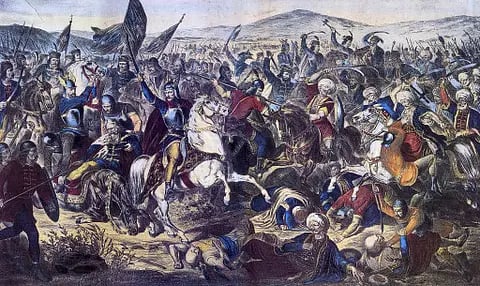"Second Battle of Kosovo (1448): The Forgotten Clash That Cemented Ottoman Control in Europe | Definitive Guide"
"Explore the pivotal Second Battle of Kosovo (1448): John Hunyadi’s Crusaders vs. Sultan Murad II’s Ottomans. Uncover tactics, betrayals, and how this clash reshaped Balkan history.


The Second Battle of Kosovo (1448): A Clash That Redefined the Balkans
The Second Battle of Kosovo (1448) remains one of the most consequential yet underappreciated conflicts in medieval European history. Fought between a Hungarian-led Crusader coalition and the Ottoman Empire, this three-day showdown marked the end of Christian resistance in the Balkans and paved the way for Ottoman dominance. In this guide, we delve into the battle’s causes, key tactics, and lasting legacy
Historical Context: Why Did the Battle Happen? 8
After the devastating Battle of Varna (1444), where Ottoman forces crushed a European coalition, Hungary’s Regent John Hunyadi sought revenge. By 1448, he rallied 24,000–47,000 troops, including Hungarians, Germans, Bohemians, and Wallachians, aiming to halt Ottoman expansion. Meanwhile, Sultan Murad II sought to consolidate control over the Balkans, leveraging Serbia’s neutrality under Despot Đurađ Branković, who blocked Albanian ally Skanderbeg from reinforcing Hunyadi28.
The Battle Unfolds: Tactics and Turning Points
Forces and Strategies
Ottoman Army (50,000–60,000): Murad II deployed a mix of Janissaries, Sipahi cavalry, and Anatolian auxiliaries. Their fortified stockades and feigned retreats lured Crusaders into traps8.
Crusader Coalition (24,000–47,000): Hunyadi relied on a wagon fort (tabor) tactic, using cannons and heavy cavalry. However, the Wallachian desertion on Day 3 crippled his flank8.
Key Phases
Day 1–2: Crusader cavalry initially overwhelmed Ottoman wings but failed to breach the center.
Night Attack (Oct 18): Hunyadi’s failed assault on Murad’s camp depleted resources.
Final Blow (Oct 20): Ottoman reinforcements encircled the Crusaders, forcing retreat. Wallachian defections sealed Hunyadi’s fate28.
Aftermath: Why the Battle Mattered
Ottoman Victory: Murad II’s win neutralized Hungary’s military power, allowing Mehmed II to conquer Constantinople (1453) and Serbia8.
Hunyadi’s Capture: The Hungarian leader was ransomed by Đurađ Branković, straining Balkan alliances8.
Legacy: The battle ended European hopes of halting Ottoman expansion, cementing their control over the Balkans for centuries78.
Key Takeaways
Strategic Use of Terrain: The Kosovo Polje (Kosovo Field) favored Ottoman flexibility over Crusader rigidity78.
Alliance Failures: Serbian and Venetian interference blocked Skanderbeg’s reinforcements, highlighting fractured Christian unity8.
Technology vs. Tactics: Despite Hunyadi’s cannons, Ottoman psychological warfare and cavalry superiority prevailed8.
Frequently Asked Questions (FAQs)
Q: How did the Second Battle of Kosovo differ from the First (1389)?
A: The 1389 battle weakened Serbia, while the 1448 clash ended Hungarian influence, enabling Ottoman dominance78.
Q: What role did Skanderbeg play?
A: His Albanian forces were delayed by Serbian blockades, a critical factor in Hunyadi’s defeat8.
Q: Why is this battle less known today?
A: Overshadowed by the 1389 battle and the 1453 fall of Constantinople, it remains a niche topic in military history7.
Conclusion: Lessons from the Second Battle of Kosovo
The Second Battle of Kosovo exemplifies the consequences of fragmented alliances and adaptive warfare. To explore related topics, check out our guides on the First Battle of Kosovo and the Kosovo War.
